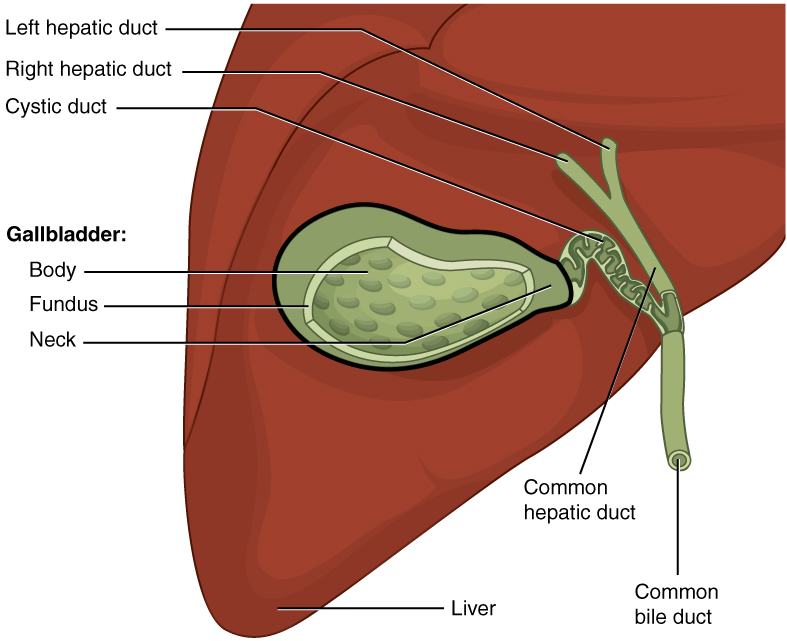Playlist
Show Playlist
Hide Playlist
Anatomy of the Gallbladder
-
Slides Anatomy of the Gallbladder.pdf
-
Download Lecture Overview
00:01 So, now let's turn to the gallbladder and the biliary tree, how bile moves throughout this system. 00:08 So the gallbladder really is just a small sack that's located on the inferior visceral surface of the liver. 00:16 And bile is made by the liver. 00:17 It's an important substance that helps to emulsify or break down fats. 00:22 So it needs to pass into the gastrointestinal tract. 00:24 And it does this by passing through the major duodenal papilla. 00:28 As we saw previously, in the middle of the second part of the duodenum. 00:34 What we end up having is throughout the liver as we have these intra and extra hepatic bile ducts. 00:39 And these are really a network of channels that allow bile to be filtered down from the liver towards this region. 00:47 So let's have a look at this in a bit more detail. 00:50 Let's start by looking at the gallbladder. 00:52 It has a fundus, which is really the part that you see sneaking out from the underside of the liver against that inferior border. 01:00 We have the main substance of the body, of the gallbladder before it narrows and tapers down towards the neck. 01:06 The channel that connects the gallbladder to this billary tree this system is known as the cystic duct. 01:12 The cystic duct is going to unite with a common hepatic duct. 01:17 And the common hepatic duct is formed from both right and left hepatic ducts, which are really drain in both the left and right side of the liver of the bile is produced. 01:29 So bile produced by the liver is fed into this common hepatic duct via the left and right hepatic duct. 01:36 It's then met by the cystic duct to form what we know as the bile duct. 01:42 The bile duct then runs towards the main pancreatic duct, which we can see running along the inner surface of the pancreas. 01:50 And the main pancreatic duct is taking pancreatic juice from the pancreas that also passes into the duodenum. 01:58 Where the bile duct and the main pancreatic duct unites, we have the hepatopancreatic ampulla. 02:05 This is a large dilation, where both the bile duct and the main pancreatic duct unite the hepatopancreatic ampulla. 02:14 Within the hepatopancreatic ampulla, there's then a small opening the major duodenal papilla, where this fluid conjoin the duodeneum. 02:23 So bile is produced in the liver and runs through the bile duct all the way to the Ampulla of Vater or the hepatopancreatic ampulla. 02:32 The Sphincter of Oddi is a strange name sphincter. 02:35 We can call it the hepatopancreatic sphincter, but some textbooks may call it the sphincter of Oddi is closed. 02:42 If that sphincter is constricted, then bile will start going back up this channel and build up within the gallbladder. 02:50 So if the sphincter is closed and bile can't enter into the duodenum. 02:55 It then backs up and is stored within the gallbladder. 02:59 The liver produces bile. The gallbladder stores it. 03:04 And whilst it's being stored in the gallbladder, it can actually concentrate it and make it a much richer fluid. 03:10 The problem with that is that actually overly concentrating bile can lead to the creation of gallstones. 03:16 And as it says here, these are present in roughly 10% of the population. 03:21 They can actually as they pass through the gallbladder actually block some of this pathway, and they can become impacted in the region. 03:28 Known as Hartmann pouch we can see here. 03:32 Small stones can actually pass through the bile duct, into the duodenum, and leave us naturally without ever knowing. 03:39 But large stones can actually become impacted around the sphincter of the ampulla. 03:44 And therefore, no bile will then be getting into the system, and it won't actually be allowed to escape through the body. 03:51 Because bile is there naturally in the circulation because it's then being absorbed by the circulatory system. 03:57 As that blood goes to the surface of the body, and it starts leaving those blood vessels due to lower blood pressure, and it seeps out, you have the yellow coloration of the skin, which is jaundice. 04:08 So, if you see that maybe there's a problem with your gallbladder and gall stones.
About the Lecture
The lecture Anatomy of the Gallbladder by James Pickering, PhD is from the course Anatomy of the Liver and Gallbladder.
Included Quiz Questions
Which 2 ducts join to form the bile duct?
- Cystic duct and common hepatic duct
- Cystic duct and right hepatic duct
- Cystic duct and left hepatic duct
- Right and left hepatic ducts
- Common hepatic duct and right hepatic duct
When is bile released into the duodenum?
- After consuming food rich in fat content
- During sleep
- During exercise
- After consuming food rich in protein content
- After consuming food rich in carbohydrate content
What is the primary role of the gallbladder?
- Concentration and storage of bile
- Production of bile
- Removal of bile
- Dilution and breakdown of bile
- Digestion of fats
Customer reviews
5,0 of 5 stars
| 5 Stars |
|
5 |
| 4 Stars |
|
0 |
| 3 Stars |
|
0 |
| 2 Stars |
|
0 |
| 1 Star |
|
0 |





